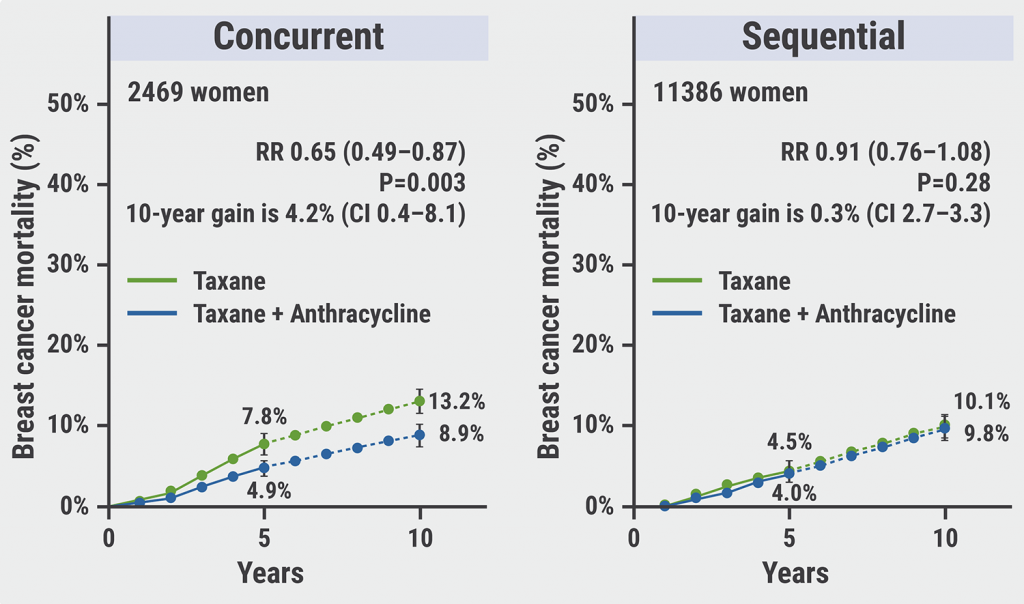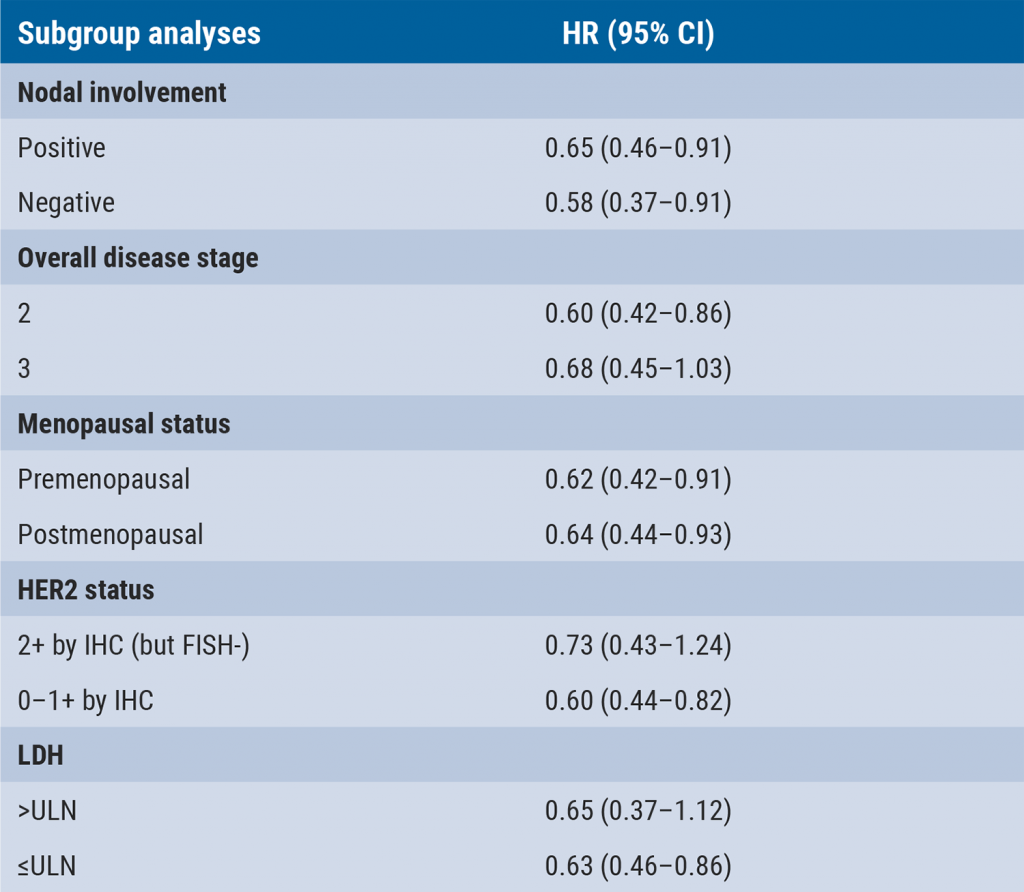https://doi.org/10.55788/cbccf707
In early breast cancer, the optimal management of the axilla is uncertain. To better understand the long-term (>10 years follow-up) benefits and risks of different approaches, the Early Breast Cancer Trialists’ Collaborative Group (EBCTCG) undertook an individual patient-data meta-analysis of randomised trials, comparing varying types of axillary treatment. Dr Gurdeep Mannu (University of Oxford, UK) presented the results [1].
For this meta-analysis, information was available on 20,273 women in 30 trials of axillary surgery or axillary radiotherapy. The trials took place between 1958 and 2009; median follow-up was 10.0 years (IQR 7.4–11.5). The results were split up for trials in the ‘pre-sentinel lymph node biopsy’ (pre-SLNB) era (1950–1990s) and the ‘sentinel lymph node biopsy’ (SLNB) era (1990s–2010s).
Trials in the pre-SLNB era compared axillary dissection versus no axillary dissection in node-negative disease, axillary radiotherapy versus no axillary radiotherapy, axillary dissection versus axillary radiotherapy, and more versus less axillary surgery. Trials in the SLNB era compared further surgery versus no further surgery in SLN-negative patients, further surgery versus no further surgery in SLN-positive patients, and axillary clearance versus axillary radiotherapy in SLN-positive patients. The majority (25/30) of the recorded trials compared no/less surgery versus (more) surgery.
The meta-analysis showed that there was no difference in 10-year locoregional recurrence, distant recurrence, breast cancer-specific mortality, or any death between less or more surgery. This was the case for both node-negative and (sentinel) node-positive patients, both in the pre-SLNB era and the SLNB era. However, in patients who underwent more surgery, the incidence of lymphoedema was doubled compared with patients with no/less surgery.
In addition, the meta-analysis showed no difference in recurrence or morbidity between axillary dissection versus axillary radiotherapy. However, axillary radiotherapy was associated with less lymphoedema.
Dr Mannu summarised that “more axillary surgery did not reduce recurrence but did increase lymphoedema. In addition, surgery did increase lymphoedema versus radiotherapy.”
- Mannu GS, et al. Overview of axillary management in early breast cancer. Abstract GS02-05, SABCS 2023, 5–9 December, San Antonio, TX, USA.
Copyright ©2024 Medicom Medical Publishers
Posted on
Previous Article
« Neoadjuvant chemotherapy may help patients skip regional nodal irradiation Next Article
Highest benefit of neoadjuvant nivolumab in breast tumours with high PD-L1 expression and/or low ER expression »
« Neoadjuvant chemotherapy may help patients skip regional nodal irradiation Next Article
Highest benefit of neoadjuvant nivolumab in breast tumours with high PD-L1 expression and/or low ER expression »
Table of Contents: SABCS 2023
Featured articles
Olaparib maintenance has favourable safety profile in TNBC
Exercise programme improves quality of life for patients with metastatic breast cancer
Living With & After Breast Cancer
Exercise programme improves quality of life for patients with metastatic breast cancer
Fast menstrual resumption after interruption of endocrine therapy
Pregnancy is not contraindicated in pathogenic BRCA carriers
Early Breast Cancer
Highest benefit of neoadjuvant nivolumab in breast tumours with high PD-L1 expression and/or low ER expression
(More) axillary surgery does not influence long-term recurrence
Neoadjuvant chemotherapy may help patients skip regional nodal irradiation
No radiotherapy after breast-conserving surgery is safe in selected younger patients
HER2-Positive Breast Cancer
Tucatinib improves PFS in metastatic, HER2-positive breast cancer
OS benefit of adjuvant T-DM1 in early breast cancer with residual disease after neoadjuvant therapy
Atezolizumab improves pCR in HER2-positive early breast cancer
HR-Positive/HER2-Negative Breast Cancer
Adjuvant ribociclib improves IDFS in early breast cancer
Addition of inavolisib to palbociclib and fulvestrant reduces risk of progression
Endocrine therapy response provides information on need of adjuvant chemotherapy
monarchE: No predictive biomarkers revealed with molecular profiling
No predictive biomarkers found in PALLAS
Triple-Negative Breast Cancer
Bilateral mastectomy and breast-conserving surgery have equal impact on breast cancer-specific mortality in pathogenic BRCA1 carriers
Olaparib maintenance has favourable safety profile in TNBC
High pCR with neoadjuvant nivolumab/chemotherapy in stage I–II TNBC
© 2024 Medicom Medical Publishers. All rights reserved. Terms and Conditions | Privacy Policy
HEAD OFFICE
Laarderhoogtweg 25
1101 EB Amsterdam
The Netherlands
T: +31 85 4012 560
E: publishers@medicom-publishers.com



